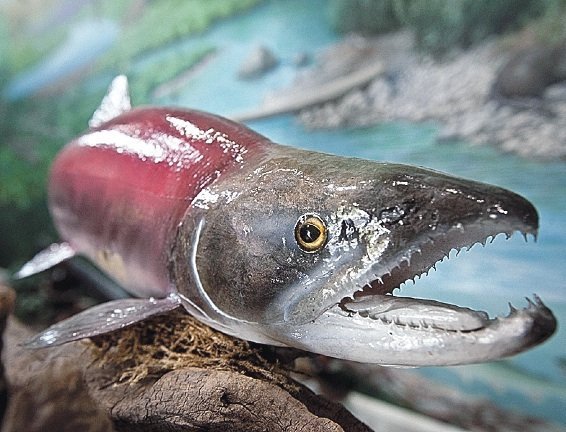forum
library
tutorial
contact

Sockeye Return Falls Far Short
of Biologists' Expectations
by Eric Barker
Lewiston Tribune, August 9, 2019
|
the film forum library tutorial contact |

|
Sockeye Return Falls Far Short
by Eric Barker
|
Only five adults have arrived at Idaho's Stanley Basin, and only a few dozen are expected to follow
 Five adult sockeye have made the 900-mile journey from the Pacific Ocean to Idaho's Stanley Basin in the shadow of the Sawtooth Mountains.
Five adult sockeye have made the 900-mile journey from the Pacific Ocean to Idaho's Stanley Basin in the shadow of the Sawtooth Mountains.
If fisheries managers are correct, only a few dozen more will follow. Idaho's most endangered fish is expected to have one of its worst showings in more than a decade. Eric Johnson, a fisheries biologist for the Idaho Department of Fish and Game at Eagle said only 25 to 30 adult Snake River sockeye may return this year.
"This will be the lowest return we have seen in the past 10 years," he said. "Our 2009 to 2018 average has been 620 adults."
Sockeye were the first of Idaho's anadromous fish runs to be protected under the Endangered Species Act. Returns to the Stanley Basin dropped to the single digits in many years during the 1990s, and in some years no fish returned. Following the sockeye's endangered designation, the state and federal governments started a captive breeding program.
In 2008 more than 900 adults were counted at Lower Granite Dam. The run peaked at 2,786 in 2014. Last year 276 sockeye were counted there.
Through Tuesday, 61 sockeye had been counted at Lower Granite. Johnson said typically about 60 percent of the sockeye counted at the dam make it back to the Stanley Basin. But biologists are increasingly suspicious that a significant proportion of adult sockeye counted at the four lower Snake River dams are not bound for the Stanley Basin. Instead, they are mid-Columbia Basin sockeye that swam off course.
Johnson said last year about 20 percent of the sockeye counted at Lower Granite Dam are suspected to have been from the mid-Columbia River. If that ratio holds true this year, it would mean only about 50 of the sockeye counted at Lower Granite are truly bound for the Stanley Basin. If 60 percent of them survive between the dam and their spawning grounds, the return to the Stanley Basin will be somewhere around 30 fish. That would be the lowest number since 2006, when the total was just 17 fish.
Johnson said the low return is likely caused by poor conditions in the Pacific Ocean and poor outmigration survival in 2017, when this year's returning adults left Idaho as juveniles. Johnson said as few as 5 percent of sockeye survived their outmigration in 2017.
But there is some reason to think the return will see an uptick next year. Ocean conditions, while still not great, have improved over the past year. So too has survival of juvenile sockeye.
The state releases as many as 1 million sockeye a year from its Springfield Hatchery in southeastern Idaho. The hatchery is relatively new, and fisheries managers were confounded by poor survival of released juveniles during its first three years. They eventually determined differences in water chemistry between the hatchery where the fish are raised in mineral-rich water and the super soft water in Redfish Lake Creek where they are released was shocking the young fish, causing many to die before reaching the ocean.
The juvenile fish are now acclimated in medium-hard water before release, and survival has improved dramatically. Next year will be the first class to return as adults under the new juvenile release regime that began in 2018. Most sockeye spend two years in the ocean.
Related Pages
Count the Fish by Government Accounting Office, Salmon and Steelhead Recovery Efforts
learn more on topics covered in the film
see the video
read the script
learn the songs
discussion forum
